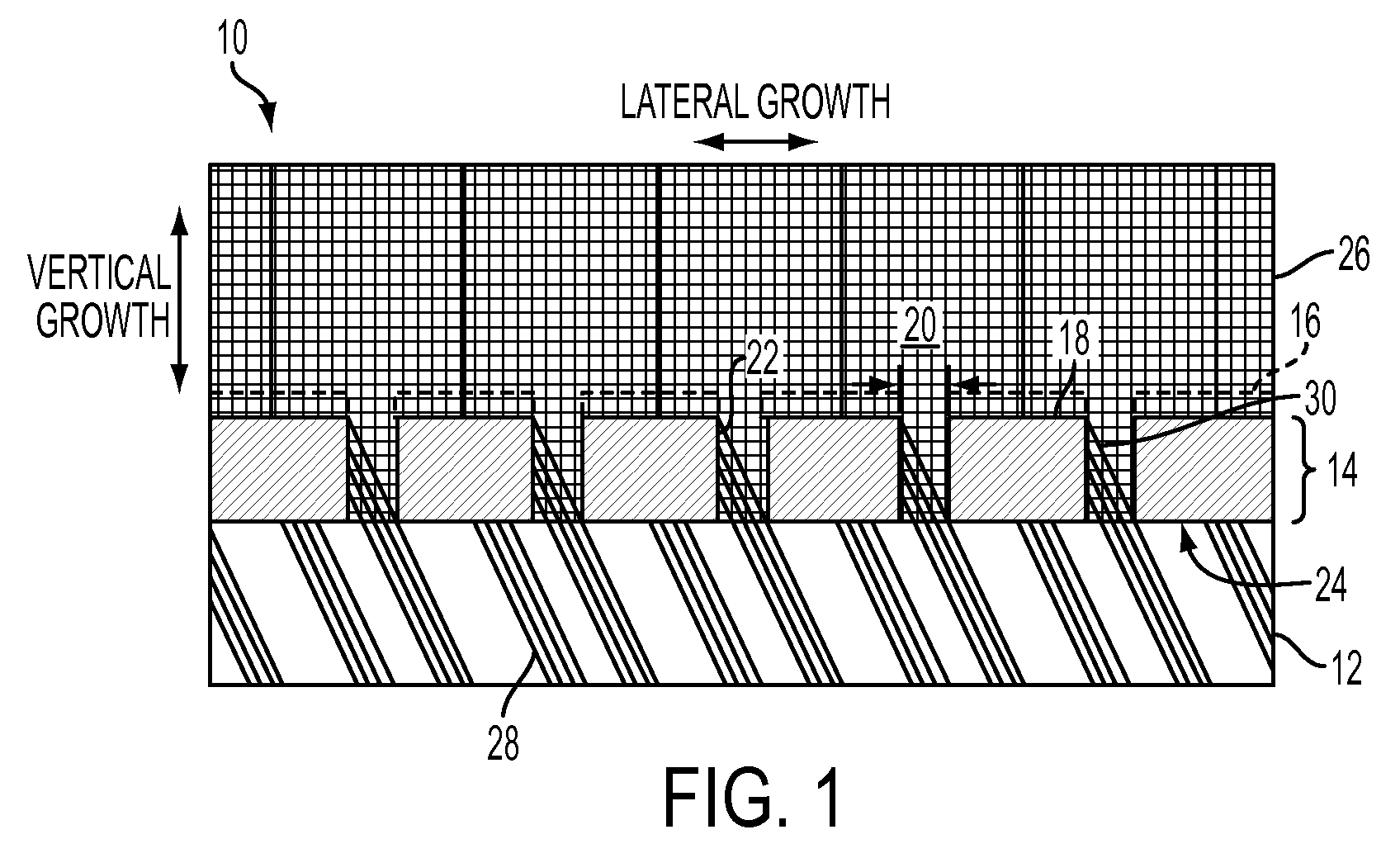Nitride Semiconductor Structure and Method of Making Same
a technology of nitride and semiconductors, applied in the direction of semiconductor devices, basic electric elements, electrical apparatus, etc., can solve the problems of relatively few options to address and prevent lattice mismatch defects, crystalline defects in the material as grown, and inability to meet the requirements of bulk substrates
- Summary
- Abstract
- Description
- Claims
- Application Information
AI Technical Summary
Problems solved by technology
Method used
Image
Examples
first embodiment
According to the present disclosure, a growth material layer is formed over a template layer. A mask is formed over the template layer, and regular “windows” are formed therein. The thickness of the masking material is selected to be greater than or equal to the product of the window width times the tangent of the angle between the surface normal and the primary plane of the template material. As the growth proceeds in the window areas, all defects tilted according to the tilt of the basal plane will be blocked by the mask.
With reference to FIG. 1, a specific example of this first embodiment is next described. A structure 10 according to this embodiment comprises a template substrate 12, which may be a 1 micron thick or thicker nitride layer (e.g., GaN, AlGaN, or InGaN or combinations thereof) of semi-polar orientation (e.g., other than (0001) or (1010) oriented surface) grown by MOCVD (or any suitable method) on sapphire or any other suitable substrate (not shown). While a gallium ...
second embodiment
In a second embodiment, the growth surface is patterned by a mask and grooves are etched into the surface with a depth greater than or equal to the product of the width of the grooves times the tangent of the angle between the surface normal and the GaN[0001] direction. This takes advantage of a large difference of growth rates along the GaN[0001] and along the opposite GaN[000-1] direction. As the former is higher and leads to defect reduction, the grooves are filled with defect-reduced material and tilted defects do not propagate to the surface.
With reference to FIG. 3, there is shown therein a structure 40 according to this second embodiment of this disclosure. Structure 40 comprises a template substrate 42, which may be a 2 micron thick or thicker nitride layer (e.g., GaN, AlGaN, or InGaN or combinations thereof) of semi-polar orientation (e.g., other than (0001) or (1010) oriented surface) grown by MOCVD (or any other suitable method) on sapphire or any other suitable substrate...
third embodiment
In a third embodiment, the growth surface is mask-patterned and grooves are etched into the surface with a depth greater than at least 0.1-0.5 μm. After etching, a masking layer is selectively deposited on all growth surfaces except for the specific facet of the grooves that points in GaN[0001] direction. This blocks any growth other than along the GaN[0001] from the highly defective seed template or substrate. Thereby, the grooves are filled with defect-reduced material and tilted defects do not propagate to the surface.
With reference to FIG. 5A, there is shown therein a structure 200 according to this third embodiment of this disclosure. Structure 200 comprises a template substrate 202, which may be a 2 micron thick or thicker nitride layer (e.g., GaN, AlGaN, or InGaN or combinations thereof) of semi-polar orientation (e.g., other than (0001) or (1010) oriented surface) grown by MOCVD (or any other suitable method) on sapphire or any other suitable substrate (not shown). A photore...
PUM
 Login to View More
Login to View More Abstract
Description
Claims
Application Information
 Login to View More
Login to View More - R&D
- Intellectual Property
- Life Sciences
- Materials
- Tech Scout
- Unparalleled Data Quality
- Higher Quality Content
- 60% Fewer Hallucinations
Browse by: Latest US Patents, China's latest patents, Technical Efficacy Thesaurus, Application Domain, Technology Topic, Popular Technical Reports.
© 2025 PatSnap. All rights reserved.Legal|Privacy policy|Modern Slavery Act Transparency Statement|Sitemap|About US| Contact US: help@patsnap.com



